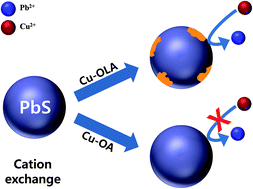Highly efficient solid-state mesoscopic PbS with embedded CuS quantum dot-sensitized solar cells†
Abstract
We synthesized a new type of PbS colloidal quantum dot (QDs) embedding CuS (PbS[CuS] QDs) by rapid injection of a sulfur precursor into a lead precursor solution followed by cation exchange of Pb with Cu ions. By the cation exchange reaction, the edge of PbS QDs was partially converted into CuS, which enhances the absorptivity of light and creates an additional absorption band in the near infrared (NIR) region due to the surface plasmon resonance (SPR) effect by the existence of vacancies in CuS. From the transient and static photoluminescence (PL) decay measurements, we found that the PL decay time of PbS[CuS] QDs was ∼2 fold longer than that of the PbS QDs and the PbS[CuS] QDs showed great PL quenching compared to the PbS QDs. Accordingly, the generated excitons in PbS/CuS QDs are more easily dissociated into free charge carriers than those in the PbS QDs. As a result, the mesoscopic PbS/CuS QD-sensitized solar cells constructed using FTO (F-doped SnO2)/bl-TiO2 (blocking TiO2)/mesoscopic TiO2/PbS/CuS CQDs/P3HT (poly-3-hexylthiophene)/Au showed 0.6 V open-circuit voltage (Voc), 20.7 mA cm−2 short-circuit current density (Jsc), 65% fill factor (FF), and 8.07% overall power conversion efficiency under 1 sun conditions (100 mW cm−2 AM 1.5G) due to the improved absorptivity and the reduced recombination of charge carriers.


 Please wait while we load your content...
Please wait while we load your content...